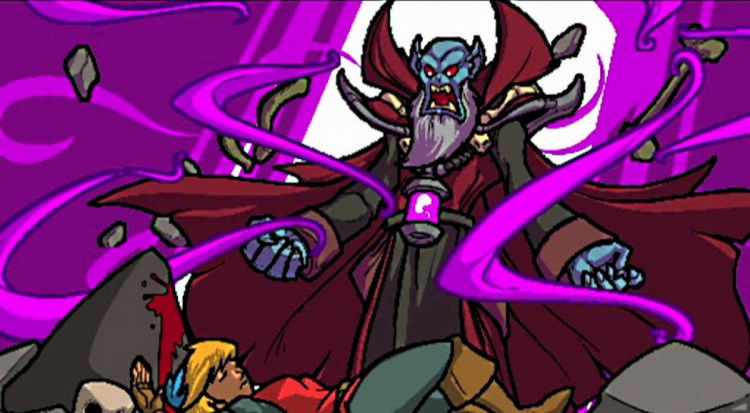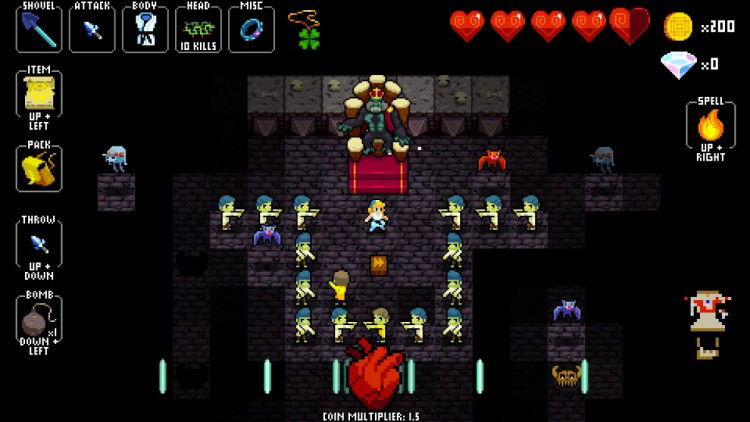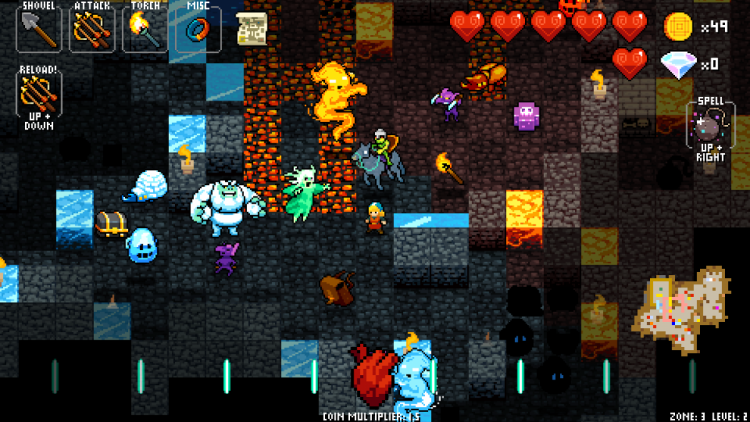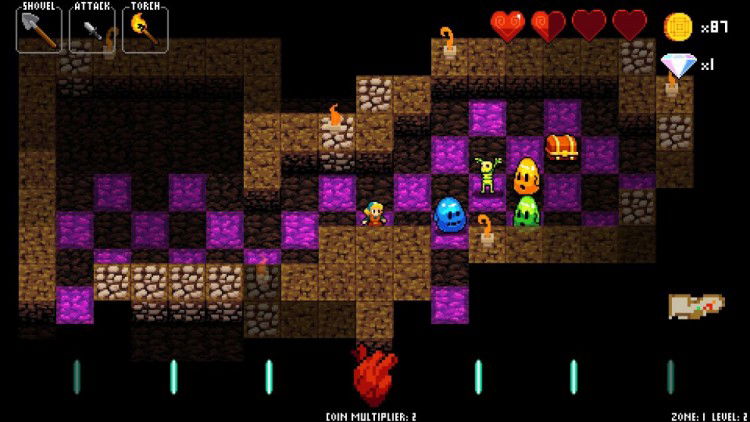Roguelikes are a tricky thing. They ask you to pay close attention to every move, demanding the utmost caution so that one does not find themselves crippled before the journey has really begun. Then, when you have poured all of that sweat into a run, and find yourself having come all of that way just to be denied at the climax, they ask you to freely give up everything you’ve earned and start again. Balance and fairness, or at least a perception of them, is key to keep players engaged. Crypt of the Necrodancer is unique in the genre in that it can often fail in that challenge, yet still draw a player in on a simple yet ingenious gameplay twist.
Game Name: Crypt of the Necrodancer
Platform(s): PC, PS4 (Reviewed), PS Vita
Publisher(s): Klei Entertainment
Developer(s): Brace Yourself Games
Release Date: 4/23/15 (PC), 2/2/16 (PS4, Vita)
Price: $14.99 (USD)
Crypt of the Necrodancer, as was mentioned, is a roguelike. However, it is also a rhythm game, and it is this which sets it apart and allows it to stand on its own (most of the time). It was released on the PC last year, but it has now been made available to console gamers with cross-buy functionality on the PS4 and Vita (I played on the former). After about thirty hours with the title, I can say that the rhythm game that Brace Yourself Games has designed is ingenious. It can certainly get frustrating, but it is addicting as all hell. The roguelike, however, leaves much to be desired.
The unique twist of Crypt of the Necrodancer is that, while its goals are much like those of any of the recent roguelikes that litter the gaming landscape (survive to the end of the dungeon and beat the boss), it all operates based on metronomic movement and combat. Each level brings a new song and tempo, and to reap the most rewards, the player must keep their actions in sync with the beat while taking advantage of patterns in the movement of the enemy. Everyone is moving on a grid, and direct contact will cause damage to both parties. Thus, the objective is usually to go around and flank foes. It is never so simple, though, as you are often dealing with four or more separate enemies, each with distinct routines, as well as environmental hazards. This is not to mention that each mistake is permanent, with vitality being in short supply and danger being everywhere. But the result is a surprisingly addicting, if flawed, gameplay experience.
Learning your enemy is just as satisfying here as it is in any Souls game, allowing you to progress a bit farther each time you start up a run. This, combined with fist-pumping, head-bobbing chip tunes, helped me to keep hitting the restart button, no matter how frustrating the game could be. Just be sure to pay close attention when calibrating the latency-I was not so wise and spent the first hour of the game in misery.
While the rhythm game was a stroke of genius and well executed, I unfortunately cannot say the same for the rest of the game. Beginning with the main form of progression, there is a sense that many of the games systems are simply in place to add variety as you slowly learn the ins and outs. Of course, there are plenty of games where the “story” or “campaign” is just another way to say tutorial, but after all of the energy that a game like this requires I would have liked more of a concrete sign of success. Instead, the diamonds that are collected during your runs are spent not on items, but the chance to obtain items from chests in-game. What this means is, as I played the most difficult levels and challenges, it was likely I wouldn’t have access to a high tier weapon I’d unlocked because it didn’t drop. Furthermore, when you do get those drops, the game becomes significantly easier, to the point of broken.
As an example, early on I found myself unable to advance past the second level of the second zone. However, on one lucky run I obtained a crossbow on the first level, and was able to breeze past the rest of the zone and the randomly selected boss without taking a hit. Obviously, in a game such as this, items should be helpful. But RNG should not be a deciding factor in whether or not the player can progress. It would have made more sense if the player could save the diamonds and select a load out prior to a run using them as a currency. It was times like this where the perception of balance and fairness I mentioned earlier was broken.
But, as I said, the frustration I found with some of the game’s meta were often overcome by how addictive the act of dancing my way around dungeons, or trying to do so, could be. While the dungeons themselves can look a bit bland, fortunately, they are filled with a good variety of interesting sprites. All of the selectable characters have a uniqueness to them as well. I was amazed at how well, when fights were close and confusing, I was able to tell apart the different types of foe and make their patterns. Admittedly, some of the larger sub-bosses can cover blocks (making anticipation of movement more difficult), and the “disco effect” of the colored floor tiles can be more distracting than anything (though, thankfully, this can be turned off), but overall the pixel art is good. It’s not as impressive as a title like Shovel Knight, but it works for different reasons.
Unfortunately, the same cannot be said of the short cut scenes and more detailed screenshots, which look, for lack of a better word, ugly. But the story, which is paper-thin, is not the star of the show here. It is the tunes. Crypt of the Necrodancer features some of the most memorable game tracks I’ve heard in a while. Even more impressive is the fact that the game doesn’t limit itself to electric dance music, but includes slower jazz, blues, and even a conga line. Not only does this serve to vary the soundtrack, but it gives variety to the gameplay, as each new tune brings with a new tempo that the player must get used to while fighting through a map. Impressive, most impressive.
The game has a lot of variety in general, extending its shelf life more than you would think. If you find the base-rhythm game enjoyable, then you could potentially have infinite hours of gameplay here. With ten unlockable characters, daily challenges, two player co-op, and the inherent randomness of the game, there is a lot here to be explored. But, if you were looking for a deep roguelike, then you might want to keep shopping.
Great Concept, Mostly Good Execution
Summary
Imagine playing Dark Souls. You’ve just saved up enough to purchase a new sword that will give you just enough reach to take out that foe from a distance. Unfortunately, you make a stupid mistake, and you die. But when you come back, that sword is gone, and you have to die fifteen more times before a random number generator decides you can have it back. Maybe you never get it back…Now, I realize Crypt of the Necrodancer is not Dark Souls. The metronomic dungeon crawler is more important than the more RPG-esque progression systems, and when you realize that, you will get the most out of the game. But, in my opinion, the game should have dropped the roguelike aspects entirely, as they frustrate an otherwise enjoyable core experience. Still, Crypt of the Necrodancer succeeds more than it fails, and should not be missed.
-
Dance the Night Away





